AI Process Simulation: How It Works
Explore how AI process simulation transforms business workflows, enhances decision-making, and drives significant operational efficiency.
Explore how AI tools enhance real-time supply chain visibility, improving efficiency, reducing costs, and mitigating risks in logistics.
Real-time supply chain visibility is transforming how businesses manage logistics. By using AI-powered tools, companies can monitor shipments, predict disruptions, and optimize inventory in near real-time. This shift is helping businesses reduce costs, improve efficiency, and stay competitive in an increasingly complex market.
AI tools are reshaping supply chain management, offering businesses the ability to respond faster, cut costs, and improve customer satisfaction. Start small with targeted AI pilots to see immediate benefits while preparing for broader adoption.
AI-powered platforms bring together tracking, prediction, and management functionalities to provide a comprehensive, real-time view of supply chains. These tools go beyond the limitations of traditional manual systems, helping businesses boost efficiency and make smarter decisions. Below, we’ll dive into the core features that make these tools indispensable.
Modern AI platforms combine GPS, RFID, IoT sensors, and telematics to offer constant updates on shipment locations, environmental conditions, and vehicle performance. They use geofencing to trigger alerts for route deviations and rely on real-time and historical data to optimize delivery paths.
By the end of 2024, the number of Internet of Things (IoT) devices globally is expected to hit 18.8 billion, marking a 13% increase from 2023. These devices can be embedded in packaging to monitor conditions throughout the journey - an especially critical feature for temperature-sensitive goods.
"Everything is only as real-time as the actual data", says Ranjit Notani, CTO and Co-Founder of One Network Enterprises.
AI algorithms continuously process real-time data to refine routes, anticipate delays, and handle disruptions. By analyzing travel patterns and using tools like estimated time of arrival (ETA) calculations, these systems can flag delays before they cause problems. Cloud integration ensures shipment details are accessible anytime, anywhere.
For instance, a global logistics company implemented AI-driven route optimization with GPS tracking. This allowed them to analyze real-time traffic alongside historical data, reducing delivery times by 20% and cutting fuel consumption by 15%.
Predictive analytics is a game-changer for spotting risks and preventing delays. By leveraging historical data and machine learning, these tools can forecast demand, identify disruptions, and streamline logistics operations. AI not only automates data analysis but also uncovers hidden patterns and generates real-time risk alerts.
Currently, 77% of logistics firms are investing in predictive analytics to improve profitability. This technology enhances inventory management by predicting lead times, evaluating supplier performance, and accounting for market demand shifts. It also improves fleet operations by optimizing routes and identifying maintenance needs before issues arise.
Walmart offers a practical example, using AI and machine learning to analyze sales data, online searches, and page views. This helps them pinpoint inefficiencies and address supply chain challenges before they escalate.
"Labor shortages, limited equipment availability, and the ripple effect of global bottlenecks are three significant challenges facing global supply chains", highlights Tom Bartman, Associate Partner at McKinsey.
While predictive analytics identifies opportunities for improvement across the supply chain, its success hinges on strong data governance, cloud-based platforms, and thorough training programs. However, it’s important to note that these tools work best when paired with human judgment and expertise.
AI tools shine when integrated with systems like ERP, TMS, and CRM, eliminating data silos and ensuring seamless updates. This alignment enables businesses to synchronize production with customer demand and streamline operations.
The results speak for themselves. For example, Trax’s AI models achieve 98% accuracy when extracting data from structured freight documents, while their pattern detection algorithms cut exception handling time by 70%. Advanced deep learning models, such as Long Short-Term Memory (LSTM) networks, have reduced error rates by 84–87% compared to traditional methods.
Integrated systems also enhance planning, improve production schedules, and provide more accurate delivery estimates. These capabilities not only increase customer satisfaction but also help ensure compliance with safety protocols by monitoring workplace conditions.
In August 2024, Wendy’s partnered with Palantir Technologies to build an integrated supply chain network, showcasing how leading companies prioritize system integration.
"The most effective supply chains connect all this information – as well as external data such as weather patterns, market signals, and partner and competitive data – and make it easily accessible to business users", says Oracle.
To implement AI-driven visibility effectively, businesses should start by auditing their existing tools, integrating data through systems like ERP and WMS, and launching small-scale AI pilots. The focus should be on selecting solutions that meet specific needs in functionality, scalability, and ease of implementation.
These features set the stage for evaluating top AI tools designed for real-time supply chain visibility.
These AI platforms go beyond the basics, offering specialized solutions to improve supply chain visibility. Here's a closer look at some of the leading tools reshaping supply chains and what makes them stand out.
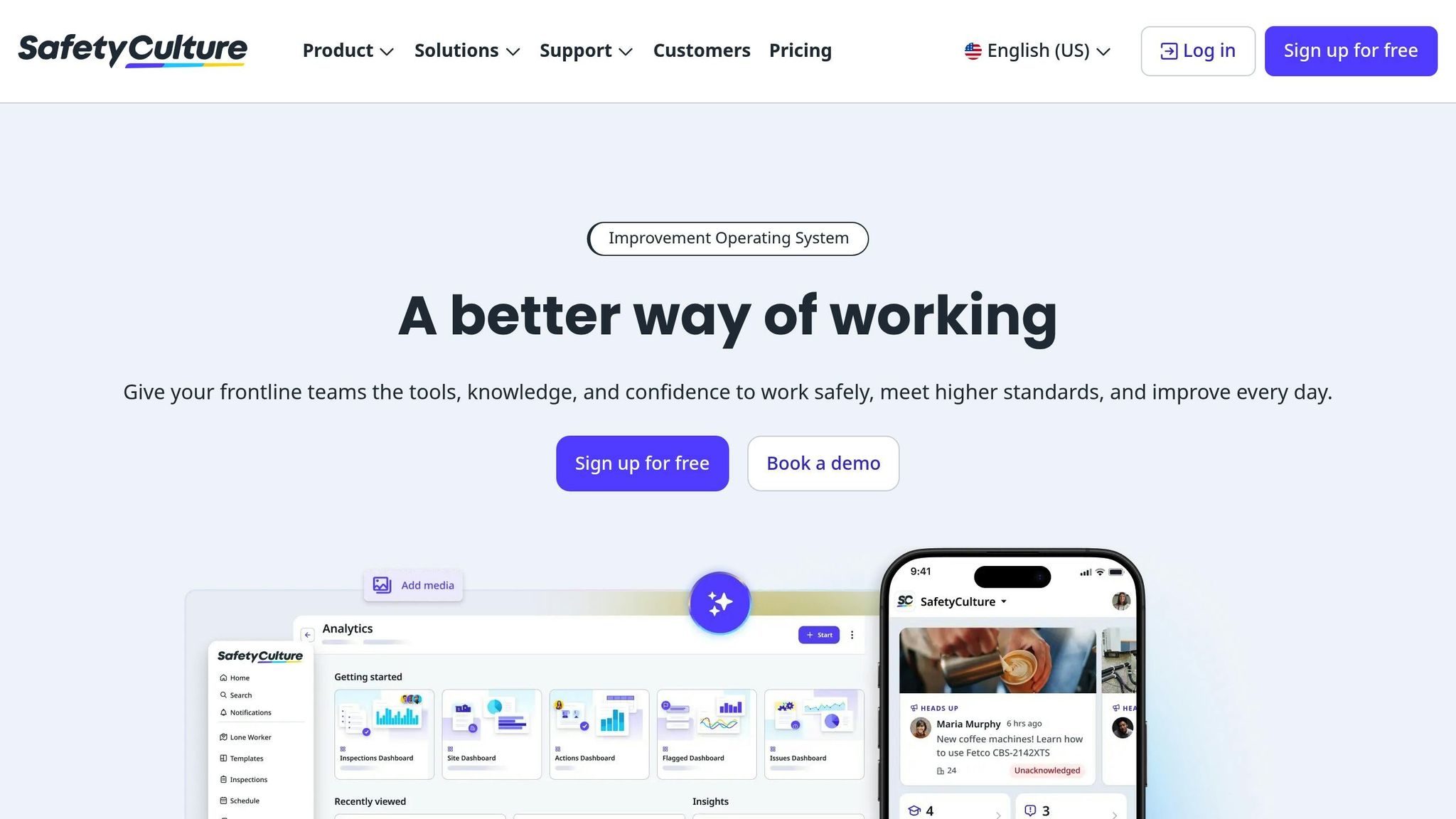
SafetyCulture's iAuditor platform uses IoT-based inspections and monitoring to streamline warehouse operations and ensure compliance. It allows teams to create digital checklists and audit workflows that automatically trigger alerts when inspections or quality checks detect issues.
Using IoT sensors, iAuditor monitors real-time conditions like temperature and humidity. Its analytics dashboards highlight deviations, making inspections more efficient. Teams can also customize templates and workflows to meet specific industry standards or internal requirements, making compliance and operational oversight more manageable.
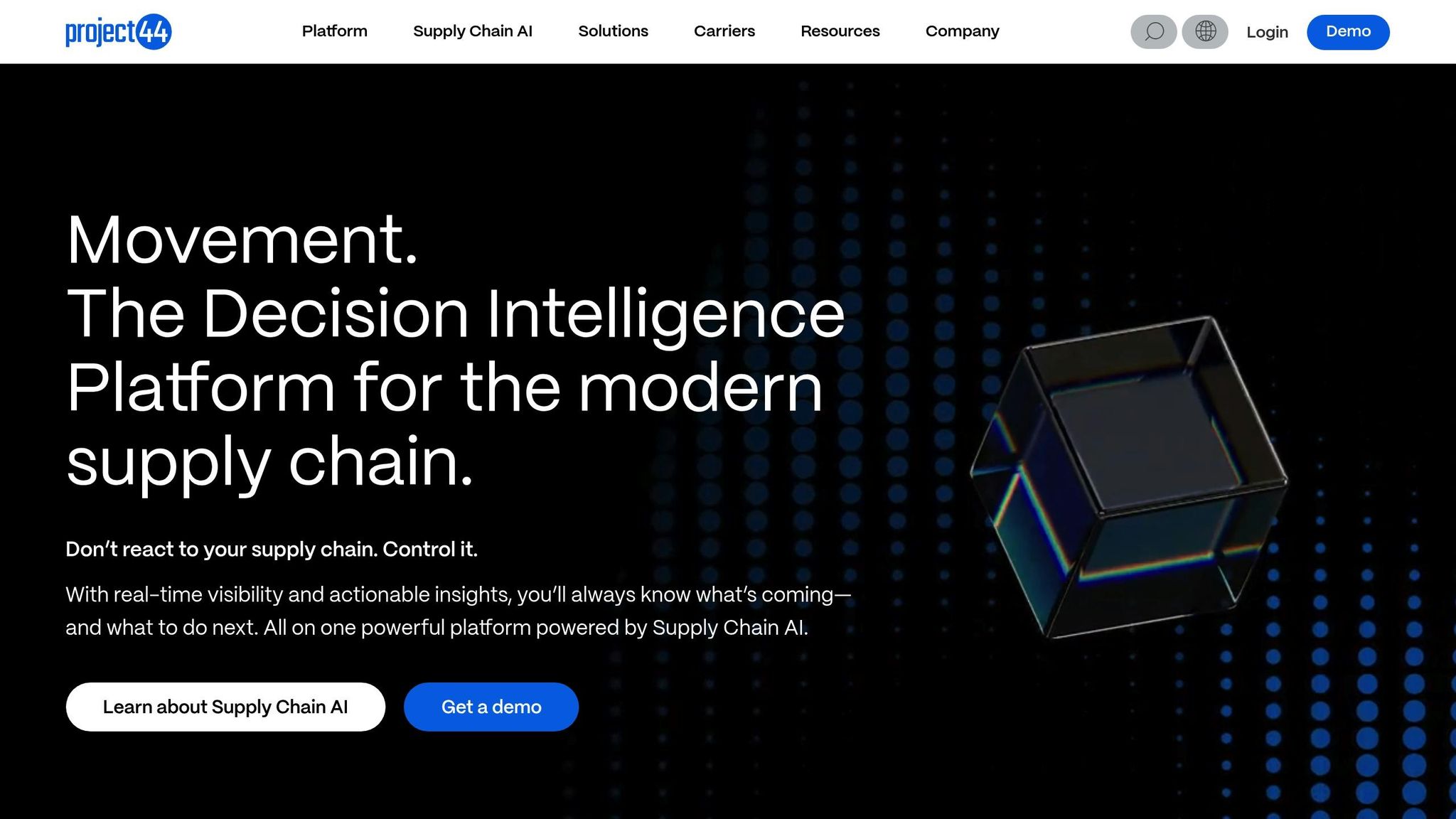
The Movement platform from Project44, powered by its AI Supply Chain Assistant MO, predicts delays and suggests alternative routes by analyzing historical data, weather, and traffic patterns. It connects to a vast network of carriers, offering visibility across multiple transportation modes and logistics partners.
Doug Cantriel, Head of North American Transportation and Modernization at Ford Motor Company, emphasizes its impact:
"project44 delivers the connected data foundation our transportation needs. What sets them apart is how they layer in workflows and AI, enabling us to gather insights efficiently and make critical decisions quickly. That execution-focused approach and collaboration is why we value project44 as a strategic partner."
Stewart Petrie, Global Transportation Excellence Manager at Pernod Ricard, adds:
"As a global leader in premium spirits, managing brands like Absolut, Jameson and Beefeater London, our network is vast and complex. The introduction of MO, project44's AI Supply Chain Assistant, is particularly exciting. This solution will revolutionize our ability to transform data into actionable insights, enhancing efficiency in our operations."
The platform automatically identifies disruptions, recommending alternative routes and carriers to maintain delivery schedules and speed up decision-making.
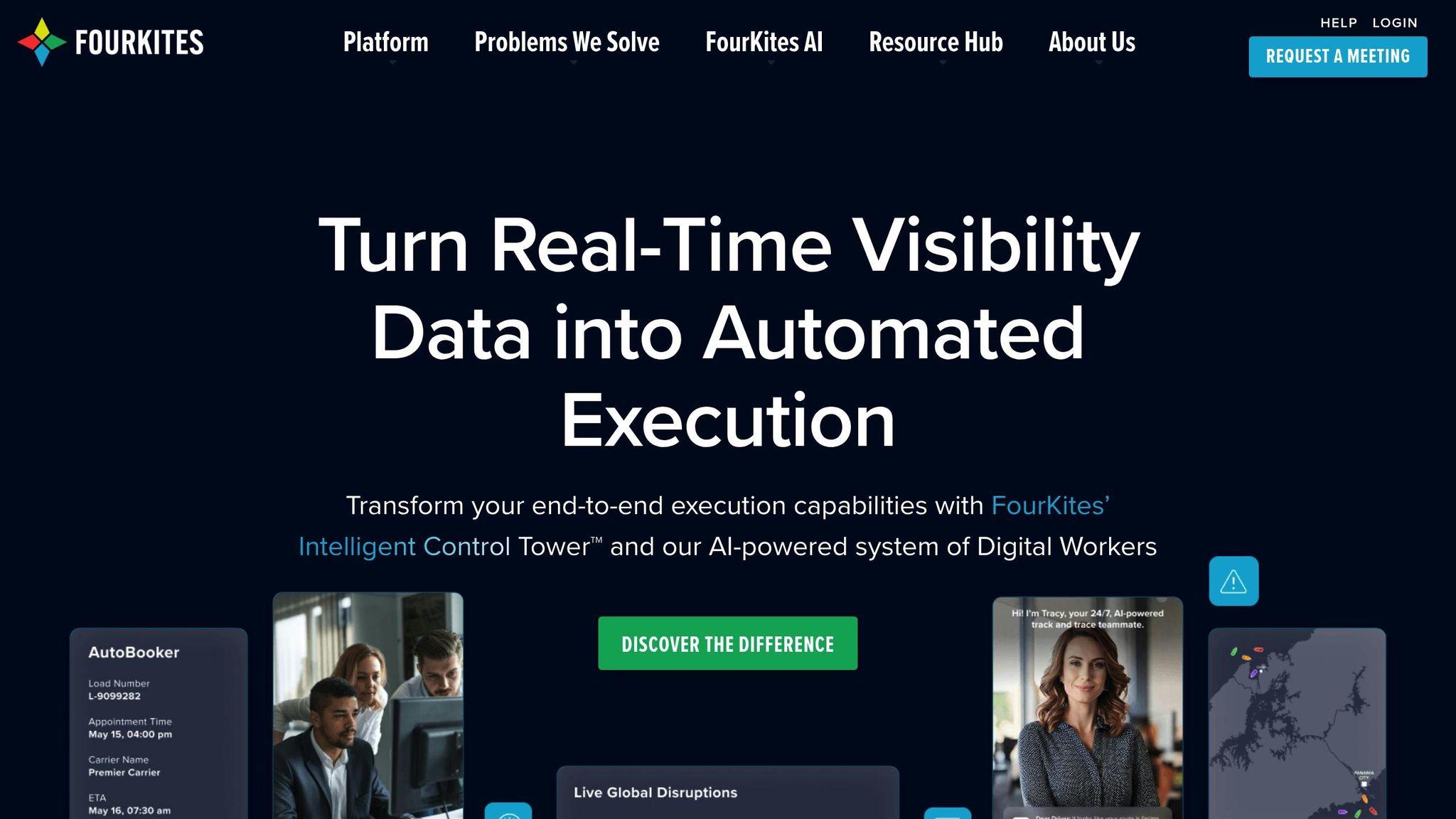
FourKites' Intelligent Control Tower provides a centralized view of shipments across all modes of transportation - ocean, rail, truck, and air. It's especially suited for businesses with diverse and complex logistics needs.
The platform tracks thousands of data points to spot potential disruptions before they affect delivery timelines. When issues arise, it alerts the relevant teams and suggests solutions based on historical data. FourKites' AI also optimizes routing by factoring in carrier performance, weather, and capacity constraints. Its dynamic ETA updates ensure accurate delivery information for both internal teams and customers, helping businesses maintain uninterrupted logistics.
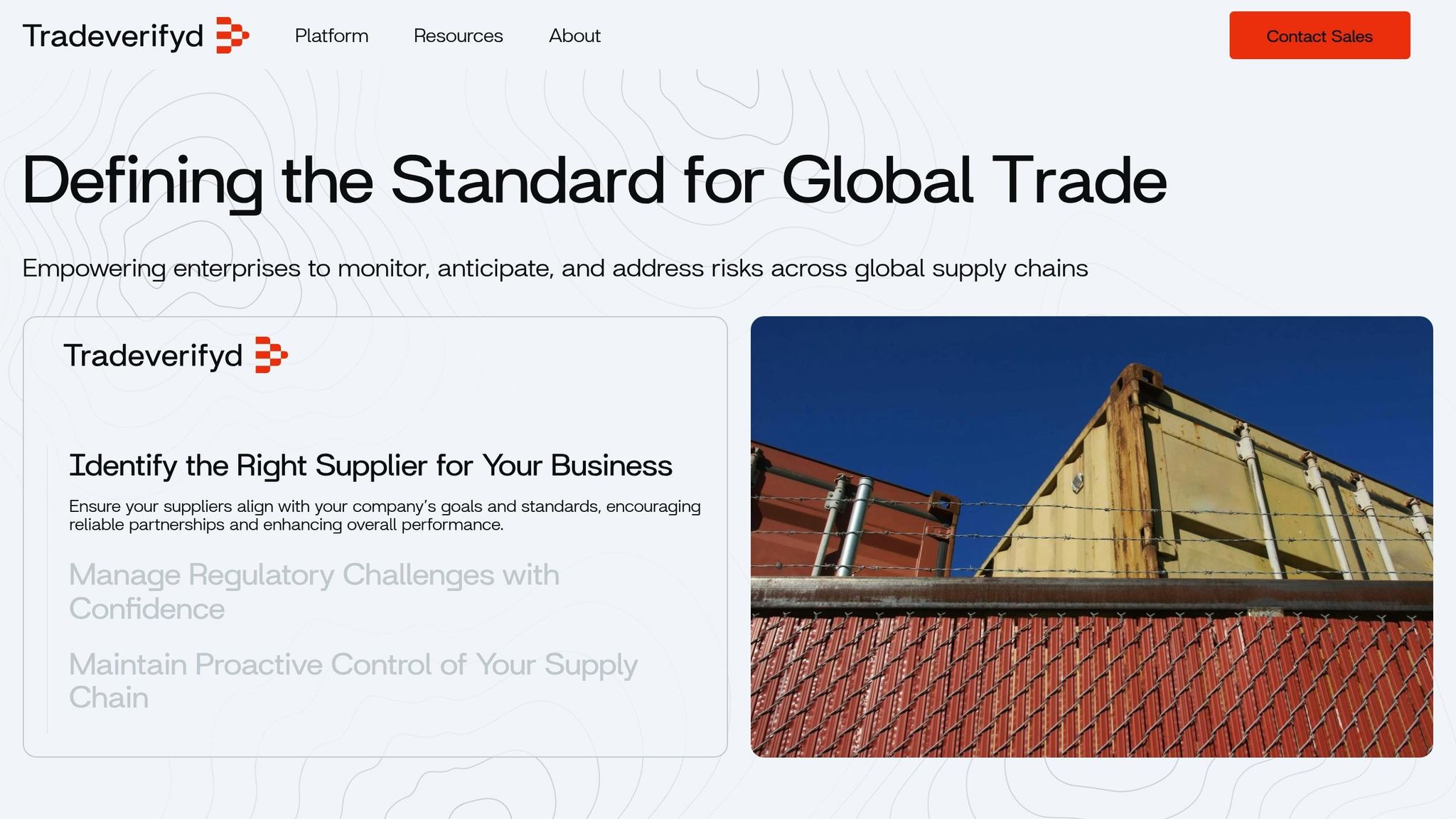
Tradeverifyd focuses on supplier risk management and compliance monitoring using AI-driven insights. Its platform continuously evaluates supplier performance, identifying risks before they disrupt operations.
The company emphasizes transparency and proactive risk management, stating:
"Our AI Agents proactively identify, monitor, and mitigate supplier risks, delivering insights with unmatched transparency."
Tradeverifyd's scoring system assesses vendors based on delivery reliability, quality, financial stability, and compliance history. It also tracks regulatory changes and evaluates their potential impact on supplier relationships, making it a valuable tool for companies in regulated industries or with global supply chains.
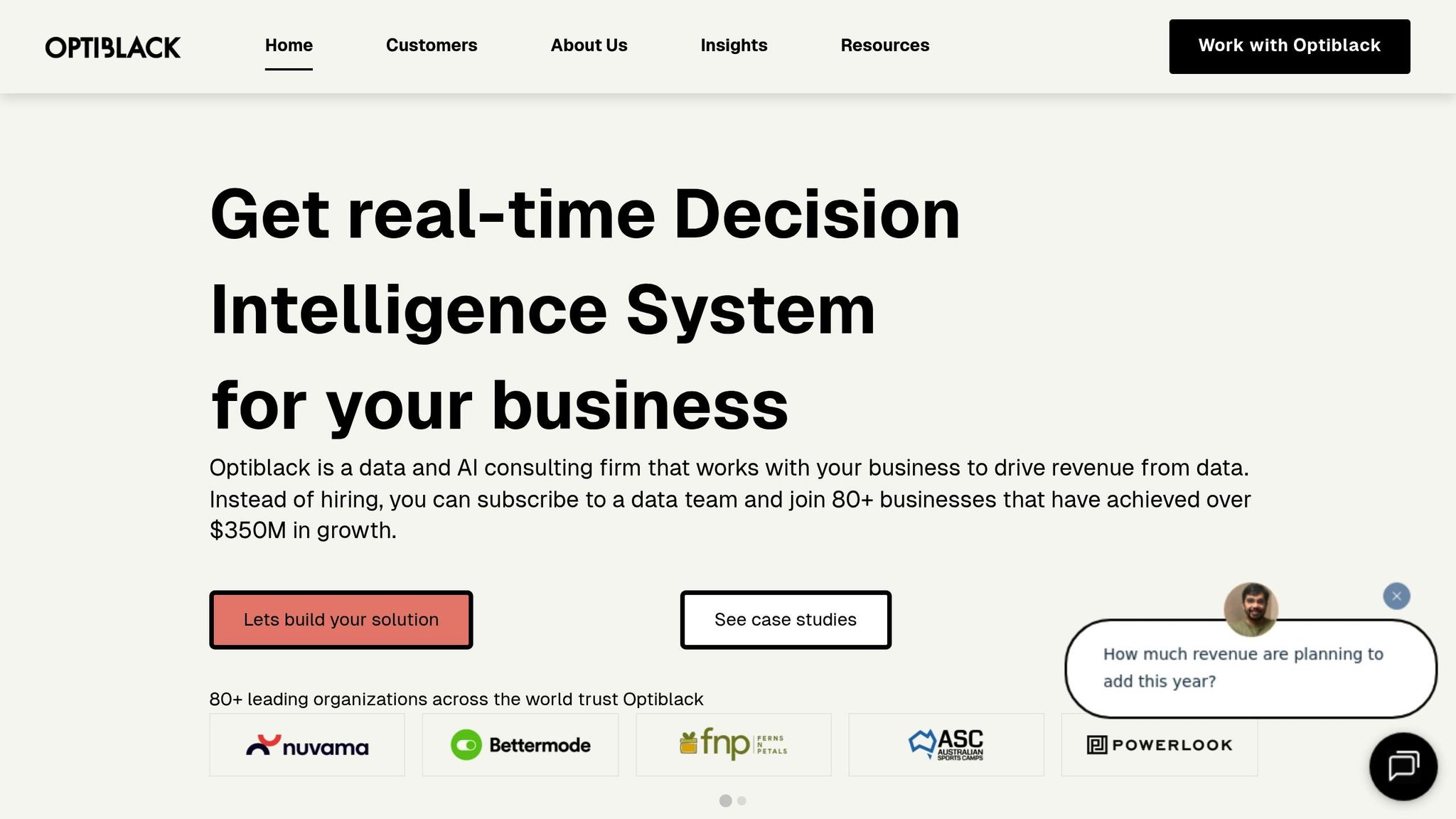
Optiblack offers a comprehensive approach to supply chain optimization, combining advanced technology and analytics. With experience working with over 40 companies and influencing $300M+ in value, Optiblack specializes in building tailored solutions for industries like SaaS, eCommerce, Fintech, and Hospitality.
The company provides integrated services such as Product Accelerator, Data Infrastructure, and AI Initiatives. These tools unify data from ERP systems, warehouse management platforms, and transportation tools, delivering real-time insights for better decision-making. By turning raw supply chain data into actionable strategies, Optiblack helps businesses uncover new revenue opportunities and improve operational efficiency.
These platforms showcase how AI is transforming supply chain visibility, offering solutions tailored to diverse operational needs, existing systems, and long-term goals. Each tool brings unique capabilities to the table, helping businesses stay agile and informed in an increasingly complex logistics landscape.
Businesses in various industries are tapping into AI-driven supply chain tools to boost efficiency, cut costs, and enhance customer satisfaction. Below are some real-world examples showcasing how AI is transforming supply chain operations.
AI shines when it comes to spotting potential disruptions before they become costly problems. By analyzing data such as weather conditions, traffic patterns, carrier performance, and historical trends, AI systems can issue early warnings, allowing companies to act proactively rather than reactively.
Procter & Gamble (P&G) showcased this capability during the COVID-19 pandemic when traditional forecasting methods struggled. P&G’s AI system analyzed live point-of-sale (POS) data, economic indicators, and even social media activity to produce accurate forecasts for individual products and stores - even for new items without prior sales data. In Japan, P&G is deploying an AI-powered forecasting system expected to reduce its delivery truck fleet by 30%, cutting transportation costs and carbon emissions significantly.
Lenovo's Supply Chain Intelligence (SCI) platform collects data from over 800 sources, including IoT devices, sensors, and enterprise systems. This advanced analysis helped Lenovo achieve a 4.8% revenue boost and a 5% improvement in on-time, in-full deliveries. Additionally, the company reduced manufacturing and logistics costs by nearly 20%.
AI doesn’t stop at preventing delays - it also optimizes inventory management to keep up with fast-changing demand.
Traditional forecasting methods often fall short in capturing rapid market changes because they rely heavily on historical data. AI-powered demand sensing addresses this gap by integrating real-time signals and adapting quickly to emerging trends.
Walmart has successfully implemented AI for inventory management. By analyzing a mix of POS data, customer demographics, weather patterns, and social media trends, Walmart’s AI system generates precise forecasts at both product and store levels. This real-time adaptability has helped Walmart reduce stockouts by 10–15% while also lowering inventory costs.
C3 AI's Demand Forecasting application unified data from 18 separate sources for a global food manufacturer, dramatically improving daily forecast accuracy and slashing the time needed to create production schedules by 96%. Similarly, a beverage company used AI to rebalance shipments across regions, resulting in a 22% reduction in aged inventory. A household goods manufacturer also saw a 14% improvement in on-shelf availability while reducing its inventory buffer.
| Category | Traditional Forecasting | Demand Sensing |
|---|---|---|
| Time Frame | Long-term (weeks or months) | Short-term (days or hours) |
| Inputs Used | Historical sales | Real-time external signals |
| Adaptability | Low | High |
| Reaction Speed | Slow | Fast |
| Team Coordination | Siloed departments | Shared real-time platform |
The challenges of 2023, including high inflation, led to a 43% rise in supplier bankruptcies and a 26% increase in site relocations or closures. AI helps businesses anticipate and mitigate these risks, offering better visibility into supply chain vulnerabilities.
Resilinc's EventWatchAI is a standout example of risk monitoring at scale. The system processes data from over 104 million sources in 108 languages, analyzing around 8 million rows daily. It uses advanced classification models to detect potential disruptions across 400 scenarios and 40 event types, providing global coverage 24/7.
For commodity markets, Resilinc's CommodityWatchAI forecasts price changes and supply constraints up to three months ahead. This gives companies the opportunity to secure alternative materials and negotiate favorable contracts well in advance.
Accenture helped a food marketing and distribution company implement an AI-powered demand forecasting system. By combining sales data with weather and dining trends, the company improved forecast accuracy by 6–8 percentage points, which could translate into $100–$130 million in potential gains.
Early adopters of AI in supply chain management report impressive results, including a 15% drop in logistics costs, a 35% improvement in inventory levels, and a 65% boost in service levels.
Choosing the right AI tool for supply chain visibility means carefully weighing the strengths and limitations of each platform. Below, you'll find a table that lays out key features side by side, making it easier to compare these tools.
| Tool | Real-Time Tracking | Predictive Analytics | Integration Capabilities | AI Functionalities | Best Use Case |
|---|---|---|---|---|---|
| SafetyCulture (iAuditor) | Basic shipment tracking | Limited forecasting | API connections to major ERPs | Basic automation and alerts | Quality control and compliance auditing |
| Project44 Movement™ | Multimodal visibility across carriers | Disruption Navigator with delay prediction | Connects to TMS, ERP, and WMS systems | NLP-based AI assistant for queries | Transportation management |
| FourKites Intelligent Control Tower™ | Real-time visibility network | AI-powered digital workers | Seamless ERP, TMS, and WMS integration | Automated resolution and collaboration tools | End-to-end supply chain orchestration |
| Tradeverifyd | Supplier tracking and monitoring | Risk assessment algorithms | Limited to compliance systems | AI-powered risk management | Compliance automation and supplier risk management |
| Optiblack | Custom real-time data pipelines | Advanced multivariate forecasting | API-first architecture for all systems | Custom AI models for specific use cases | Tailored solutions for complex operations |
This comparison highlights distinct differences in functionality. For instance, Project44 Movement™ excels in multimodal visibility and includes tools like the Disruption Navigator and an NLP-based AI assistant, making it a strong choice for companies handling complex transportation networks. On the other hand, FourKites Intelligent Control Tower™ shines with its real-time visibility network and AI-powered digital workers, streamlining resolution and collaboration for end-to-end supply chain management. Meanwhile, Tradeverifyd is the go-to option for compliance automation and supplier risk management, thanks to its AI-powered risk assessment capabilities.
Building on the insights in the table, the evaluation process prioritizes operational impact and ease of implementation, especially for U.S. businesses. Integration simplicity is a key factor, as seamless data connectivity remains a major hurdle in deploying AI solutions effectively. The most effective tools integrate with platforms like IoT devices, ERPs, and logistics software to ensure continuous data flow.
Pricing for AI tools varies widely, from $10,000 for basic systems to over $1,000,000 for enterprise-level deployments. Companies that have adopted AI-enabled supply chain tools report impressive results: logistics costs reduced by 15%, inventory levels improved by 35%, and service levels enhanced by 65%. Customization plays a critical role for businesses with unique operations, as tailored AI solutions offer better adaptability, faster responses, and models designed specifically for their needs. Notably, companies that scale AI strategically see three times higher ROI compared to those taking a siloed approach.
Scalability and maintenance costs are also significant considerations, typically amounting to 15–25% of the initial investment annually. Cloud-based solutions often provide a cost-effective alternative, cutting upfront expenses by 40–60% compared to on-premises systems.
For U.S. businesses, additional factors like regulatory compliance, integration with domestic carriers, and change management processes are vital. This analysis equips decision-makers with the knowledge needed to choose an AI tool that enhances real-time supply chain visibility while aligning with their specific needs and goals.
AI has reshaped supply chain visibility, turning it into a powerful advantage for U.S. businesses. Companies using AI-driven visibility tools have reported impressive results - inventory levels dropping by 35%, logistics costs shrinking by 15%, and service levels improving by 65%. This marks a total transformation in supply chain management.
The benefits go beyond cutting costs. Real-time tracking and predictive analytics allow businesses to spot disruptions early. For example, a major building products distributor saw fill rates climb by 5% to 8% thanks to an AI-enabled supply chain control tower. Similarly, a logistics provider increased warehouse capacity by nearly 10% - without expanding its physical footprint - by using AI-powered digital twins.
Improved visibility doesn’t just save money; it also keeps customers happy. Companies with advanced AI in customer service report 17% higher satisfaction rates. This matters because 51% of U.S. consumers expect two-day delivery, and 29% are willing to switch brands if items are out of stock.
AI tools also excel at mitigating risks. Businesses that successfully adopt AI can cut recovery times in half and reduce new product lead times by 30%. These capabilities enhance operational stability and strengthen competitive positioning - making AI an indispensable tool for modern supply chains.
For companies looking to get started, the best approach is to focus on low-risk, high-impact projects that deliver quick results. The gains from these early efforts can then be reinvested into broader AI strategies. In today’s fast-paced market, AI-powered supply chain visibility isn’t just an option - it’s a necessity.
AI tools are transforming how businesses achieve real-time supply chain visibility. By continuously analyzing massive data streams from sources like ERP systems, IoT devices, and logistics platforms, these tools can spot patterns, predict disruptions, and deliver actionable insights on the fly. This means businesses can make smarter, faster decisions without delay.
Traditional methods often rely on static reports and outdated information. In contrast, AI empowers proactive management and offers end-to-end visibility. This capability helps companies stay ahead by anticipating demand shifts, reducing delays, and tackling challenges head-on - all while boosting efficiency and keeping customers happy.
Integrating AI into business systems like ERP (Enterprise Resource Planning) and TMS (Transportation Management Systems) can reshape how supply chains operate, offering several standout advantages:
Beyond these, AI plays a crucial role in cutting costs, improving supply chain visibility, and creating more resilient operations. By embracing AI, businesses can remain competitive and adapt to the fast-evolving demands of the global market.
To make AI tools work effectively for real-time supply chain visibility, companies need to start with a clear game plan. This means identifying specific goals like improving demand forecasting, fine-tuning inventory management, or making shipment tracking more seamless. But here's the catch: none of this works without clean, accessible data. So, getting your data in order should be a top priority before diving into AI implementation.
Taking it step by step is the way to go. A phased rollout, working closely with AI experts, and having a solid change management strategy can make the transition much smoother.
That said, there are some bumps along the road. Challenges like finding skilled talent, dealing with messy or incomplete data, managing upfront costs, tackling employee pushback, and ensuring data security and privacy are all part of the journey. But with a well-aligned team, smart planning, and the right tech setup, businesses can navigate these obstacles and tap into the advantages of AI-powered supply chain visibility.
Explore how AI process simulation transforms business workflows, enhances decision-making, and drives significant operational efficiency.
Explore how real-time anomaly detection in edge computing enhances efficiency, reduces costs, and transforms various industries.
Explore how real-time AI-powered risk reporting enhances decision-making and risk management by providing continuous insights and predictive...
Be the first to know about new B2B SaaS Marketing insights to build or refine your marketing function with the tools and knowledge of today’s industry.